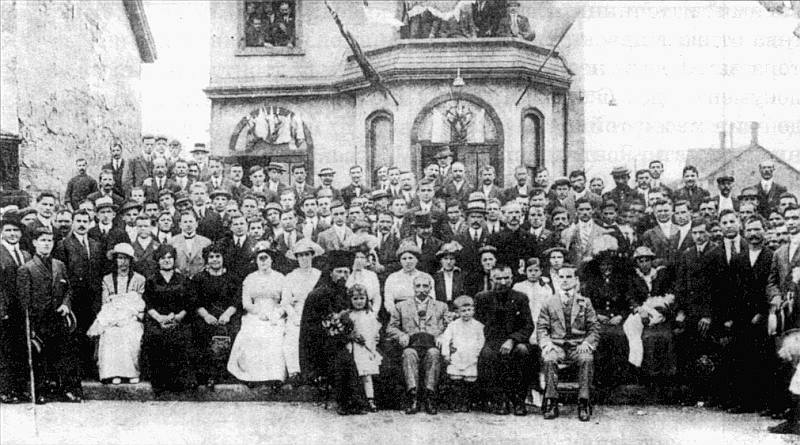
Ethnical groups from other
European countries came to Canada almost simultaneously with the
English and French settlers. In 1870 thousands of Europeans settled in
the western prairies.
Later on, some Bulgarians who had left their native country compelled
by the difficult conditions and the centuries-long Turkish yoke also
went there. The number of Bulgarian emigrants to Canada increased after
the Ilinden Uprising, towards the end of the Balkan Wars and after the
end of World War I. Those were both people who had lived within the
Bulgarian borders and compact masses of population from Vardar and
Aegean
Macedonia.
Most of Bulgarian emigrants to Canada left their mother country because
of the difficult economic situation and because they were attracted by
the opportunities for a better life. Many of our compatriots arrived in
Canada with the sole intention of earning quick money and then
returning to their native lands. Therefore, most of them lived in
Canada only temporarily.
Between the two World Wars the flow of emigrants from Bulgaria to
Canada was rather variable. Larger groups were registered in the
1923-1930 period mainly because of the poor economic status of the
country. A part of Bulgarian emigrants came to Canada through the
United States.
After the establishing of communist dictatorship in Bulgaria in
September 1944 and the communist terror that followed during the next
several years, some of our compatriots left the motherland for
political reasons and part of them settled in Canada. This category
also included Bulgarians who had left their places of birth before or
during the war to study or work in various European countries and after
the end of World War II went to Canada.
Although Bulgarian governments till 1944 made attempts at regulating
the flow of emigrants towards North America by enforcing laws and
regulations, all their efforts were unavailing.
The communist totalitarian regime which was enforced onto the country
as a matter of fact prohibited legal emigration. Nevertheless, many
sons and daughters of Bulgarian were driven away by the dictatorship
and were compelled to leave the country without legal permission and
take on the hard lot of emigrants in Canada.
The first Bulgarian emigrants to Canada took part in the intensive
railroad construction that was developing at that time. Our compatriots
worked on the preparation of the railroad-beds, the blowing up of rock
massifs, boring through of tunnels, bridge building, etc. Since these
were not safe activities, many of the workers became disabled. Other
Bulgarians earned their living as coal miners, woodcutters in forest
exploitation, workers in slaughterhouses and factories, construction
workers, waiters, etc. Since they were not educated they were used
predominantly for unskilled and semi-skilled labour. They were the last
to be hired and the first to be fired. Almost all of them suffered the
hard lot of the unemployed.
Those pioneer emigrants used to work 16 hours a day, often for a crust
of bread and a bowl of soup. They lived in cabins and caravans under
difficult and unhealthy conditions. Sometimes lodgings for seven
persons housed up to thirty people.
At the price of unconceivable efforts and tremendous privation some of
the Bulgarians in Canada managed to put some money aside and start
their own businesses: they became grocers, cafe-keepers, bakers, pastry
shop owners, hotel-keepers, restaurant owners, merchants, etc. Having
stabilized economically, they called for their relatives from the
native lands and up the idea of going back home. In this way, the
initial purpose of Bulgarians who went abroad to make a living gave way
to their permanent settling in the new lands. This, in its turn, raised
the necessity for organized cultural activities.
The organizations, unions, societies, associations, and clubs of
Bulgarians living in Canada played an important part in their
sociopolitical, economic and cultural life. The integration on the
larger part of these people into the life of their new country was
enhanced mainly by patriotic motives.
Bulgarian emigrants' organizations, friendly societies and different
associations in Canada carried out various activities. Some of them
assisted the adapting of Bulgarian emigrants to the local way of life
and their integrating into the new society. Others tried to keep up the
national traditions and customs and popularize them among our
compatriots by organizing festivities, dance parties, celebrations,
lectures, etc.
Bulgarians living in Canada preserved the original character of their
national customs and feasts, the architecture of their houses and
certain elements of the house interior. Their national folk costumes
corresponded fully to the Bulgarian tradition which continued to live
in such genres of applied arts as handiwork, pottery, etc. The national
cuisine dishes were very popular and food preferences were among the
main strongholds of cultural identity.
Bulgarian emigrants in Canada preserved and developed the national
amateur arts—dramatic, musical, choir, dancing. They organized their
own ensembles, choirs and orchestras and took part in musical
festivals, carnivals, etc. Our compatriots made an indisputable
contribution to the development of some musical, choreographic,
painting and applied arts in Canada.
The author discusses the activities of Bulgarian emigrants' political
parties and organization in this remote country. He also considers me
emigrants' organizations of anti-Bulgarian character.
The majority of organizations developed by the Bulgarian community in
Canada published their own printed materials which broadened the notion
of their social and cultural life. The printrun of these publications
was not high and they were not issued regularly. They were supported
financially mainly by the members of the respective organizations
through voluntary donations and offerings, the exception being only a
few communist editions whose editors-in-chief received financial
support through secret channels with the assistance of the local
Bulgarian agencies, in cases of high unemployment rate among the wide
masses of Bulgarian emigrants their papers ceased to be published.
Along with some general problems, these editions treated for the most
part the life and activities of the members of the organization which
published them, or of the related ethnical group or community.
Bulgarian congregations in Canada supported churches, priests,
organized Bulgarian language schools and paid for the teachers. The
main reasons for the establishing of Bulgarian Eastern Orthodox
churches in Canada were the preserving on the part of Bulgarian
emigrants the Orthodox faith, their national affiliation, the
centuries-old traditions and customs, as well as their desire to keep
and study their native Bulgarian language. The broad activities of
public utility prevented the assimilation process to which our
compatriots were subjected and played the role of integrating and
ethnic-differentiating factors.
With the purpose of keeping and asserting the national Bulgarian
spirit, language and faith of both the older Bulgarians and their
generations, a Bulgarian school was opened in Canada as early as 1914.
It is considered to be the first Bulgarian language school in the New
World ever opened by Bulgarian emigrants. Young Bulgarians studied
there Bulgarian language, Bulgarian history and geography and were
educated in the lines of Bulgarian national awareness and patriotism.
Later on, in the early 1930's, the school subjects were enriched by
religion and singing classes. The school year usually began in the
autumn months and ended by May 24th or July 1st with a kind of
examination in the presence of the parents and all interested. Very
often teachers in Bulgarian schools did not have the necessary
qualifications. They made their living in other ways. Most often they
served as priests in the local Bulgarian churches.
Broadcasting in Bulgarian language from Toronto was performed to
maintain the national consciousness and to spread information about the
mother country, about the life of Bulgarian emigrants in Canada. At
first it was broadcast every Saturday and provided our compatriots with
information about trade, social and other events. The beginning of
these feature programmes was laid as early as the 1950's. They were of
historic, musical and literary character.
Since November 15th 1978, a children's hour began to be broadcast every
Wednesday in the Bulgarian radio programme in Toronto. Nowhere else
around the world where Bulgarian emigrants lived was there such a
children's hour at that time. This programme was welcomed by both the
young listeners and their parents. In broadcast dramatized Bulgarian
fairy tales and children's songs.
In the evening of September 8th 1979 the first Bulgarian TV programme
in Toronto was shown. It provoked great interest among Bulgarian
emigrants in Canada.
A typical feature of the Bulgarian community in Canada was the
difference in the economic welfare between the older emigrants and
those who settled in Canada after the end of World War II. Most of the
old Bulgarian emigrants who came to Canada to earn their living were
usually people without education who made their living through hard and
unskilled labour.
The new Bulgarian emigrants were better educated and managed to adapt
more easily to the Canadian reality. Thus they had the chance to
achieve a better economic and social status among the medium and higher
stratus of Canadian society.
The contemporary generation of Bulgarian descendants in Canada had, to
a great extent, lost their knowledge of the language of their
predecessors, as well as some of their Bulgarian ethnicity. A reaction
on the part of those young people to that phenomenon, however, was the
interest that aroused of late in Bulgarian musical folklore and folk
dances containing Bulgarian original national elements.
When the first Bulgarian emigrants to Canada decided to settle there
for permanent, they did their best to build themselves nice houses, to
make their life as comfortable as possible, to provide certain goods
for their children whom they wanted to live a better life and feel like
free people. Their story is an epic of many sufferings and hopes, but
at the same time it is an epic of a heroic labour and unconceivable
efforts, as well as of certain undisputable achievements.
Although Bulgarian emigrants to Canada constituted one of the smallest
ethnic groups, and despite the hardships and privations they had to
suffer in order to survive in new country, they managed to assert
themselves among the foreign and much more numerous ethnic groups and
to give their contribution, which was not insignificant, to the
socio-political, economic and cultural development of Canada.
Excerpt
from "Bulgarian emmigration in Canada" by Kostadin Gurdeff

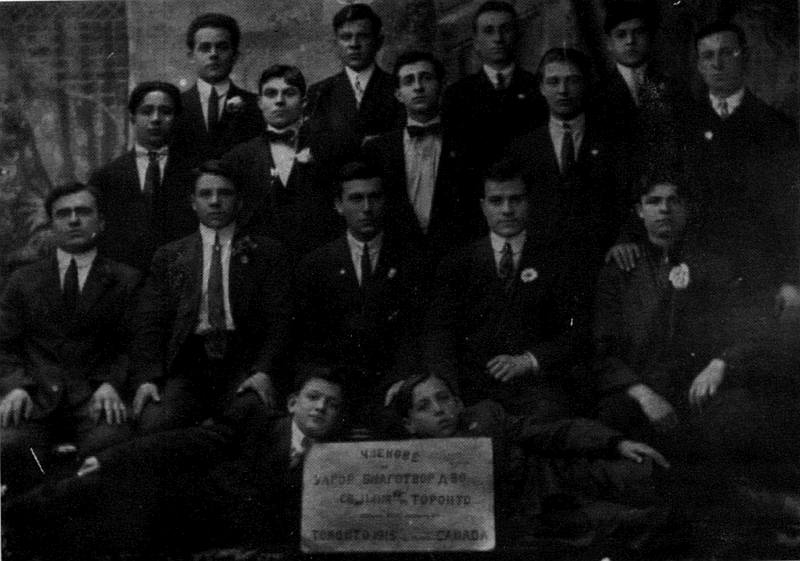
Members of the Zagorichani Charity Organization "St. Ilija" in
Toronto, 1915
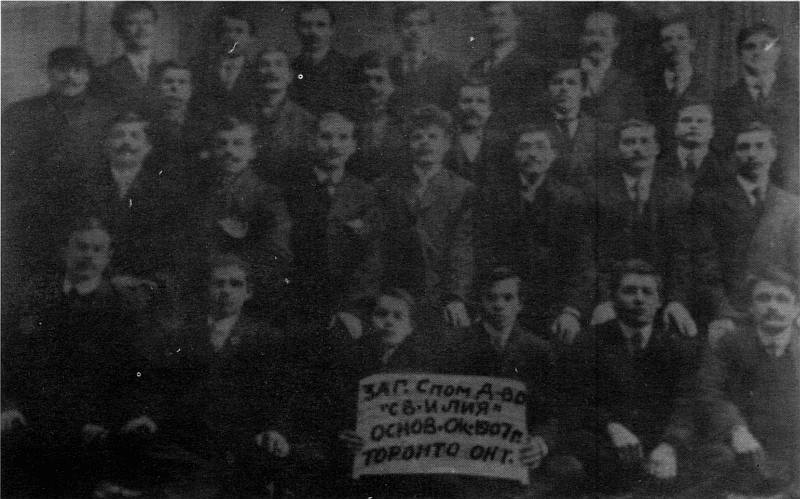
Members of the Zagorichani Charity Organization "St. Ilija",
founded in October 1907 in Toronto
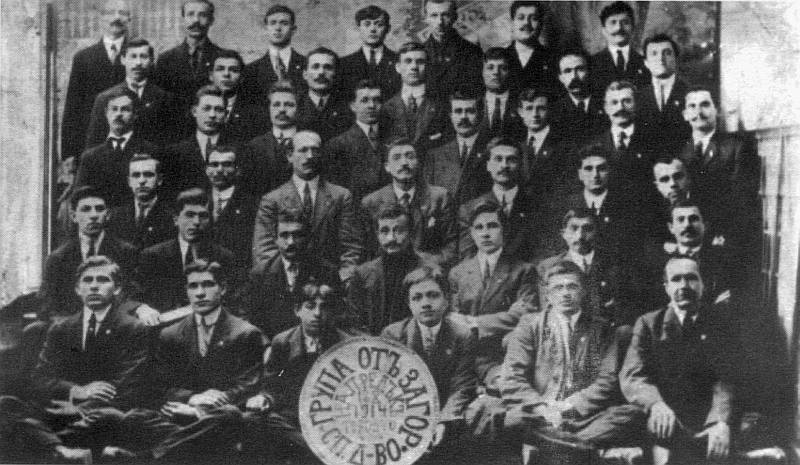 Members of the former Zagorichani Charity Organization
"Napredak", founded on 21.11.1914
Members of the former Zagorichani Charity Organization
"Napredak", founded on 21.11.1914
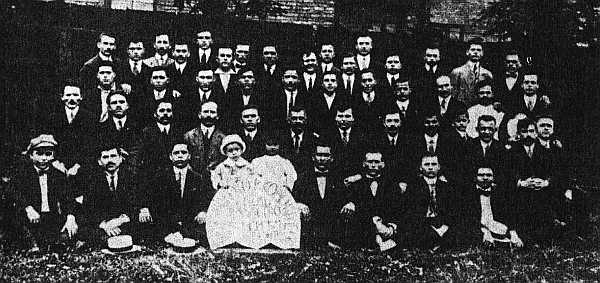
Members of the Bulgarian
Charity Organization "Tursie"in Toronto. Almost all of them are from
the village of Tursie, Lerin.
The names of the organizations
are in literary
Bulgarian language!
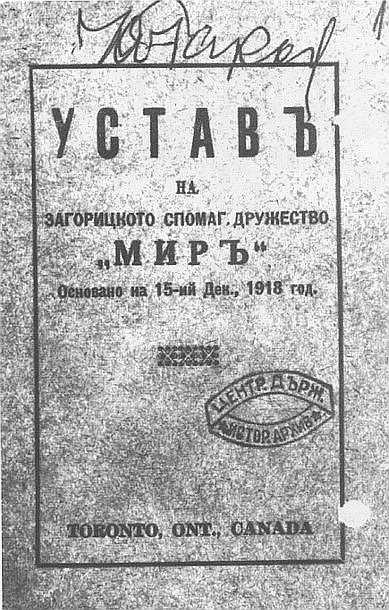
The frontpage of the statute
of Zagorichani Charity Organization "Mir", founded on 15.12.1918 in
Toronto
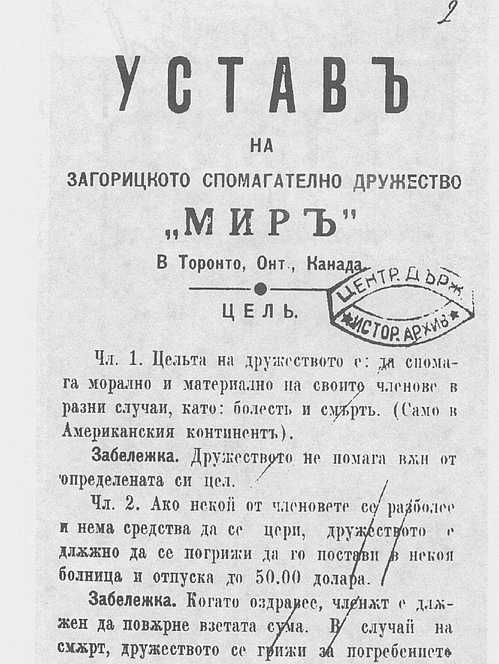
Statute of Zagorichani Charity Organization "Mir"
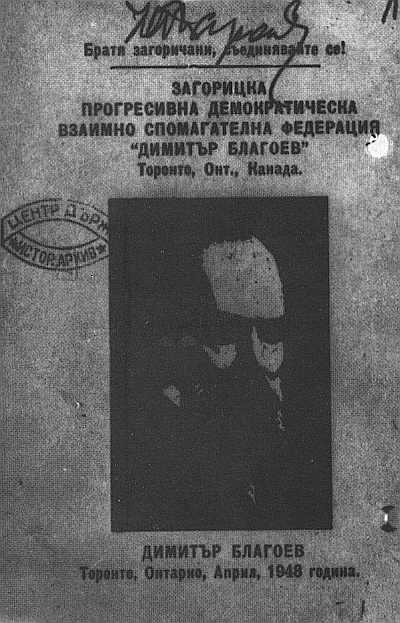
Zagorichani progressive
democratic mutual aid federation "Dimitar Blagoev", Toronto, 1948
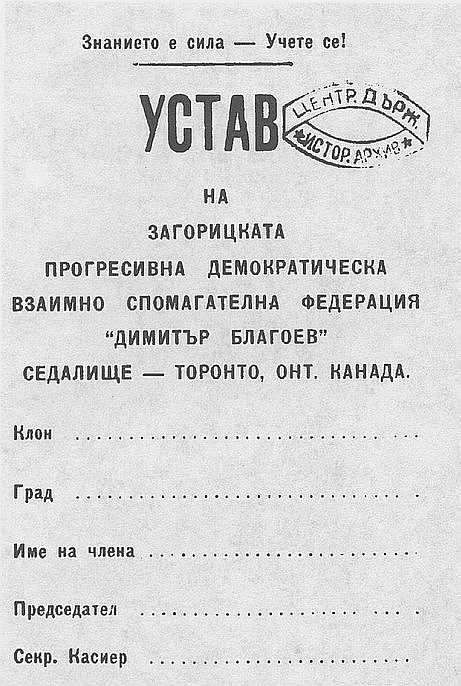
First page of the statute of Zagorichani progressive
democratic mutual aid federation "Dimitar Blagoev", Toronto
All documents are written in literary Bulgarian language!
Pictures 1 and 3 below were taken from the Macedonian web
site http://www.macedonianhistory.ca/. According to the title of the
first picture it is supposed to represent the inauguration of "the
first Macedonian church in Canada" but it is enough simply to have look
at the photo to see more than 20 bigger or smaller Bulgarian flags!
This fact is indicative of the vicious practice of the so called
"Macedonian historians" to compensate for the lack of any documents
proving the existence of Macedonians prior 1944 by falsifying Bulgarian
history and changing the truth about the Bulgarian population of
Macedonia.
The second picture shows the first page of the minutes from the session
on March 11, 1911 of the council of the same church ( "St. St. Cyril
and Methodius" in Toronto)
They are written in literary Bulgarian
Language.
The inscription on the third picture is in literary Bulgarian
language.
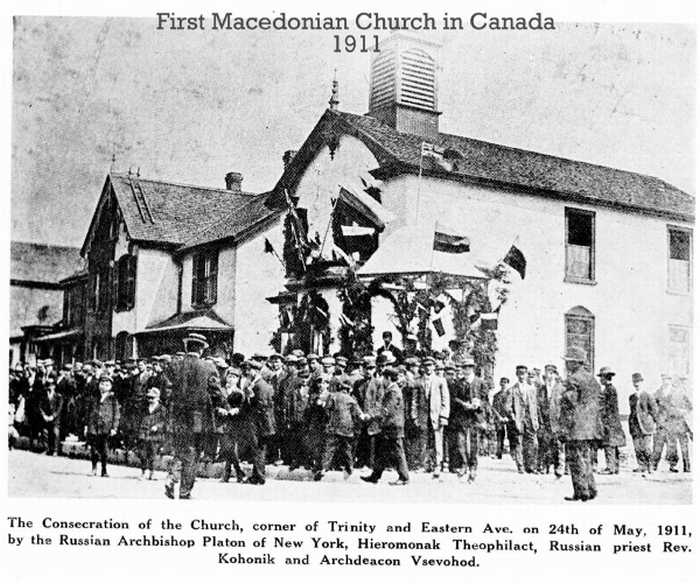
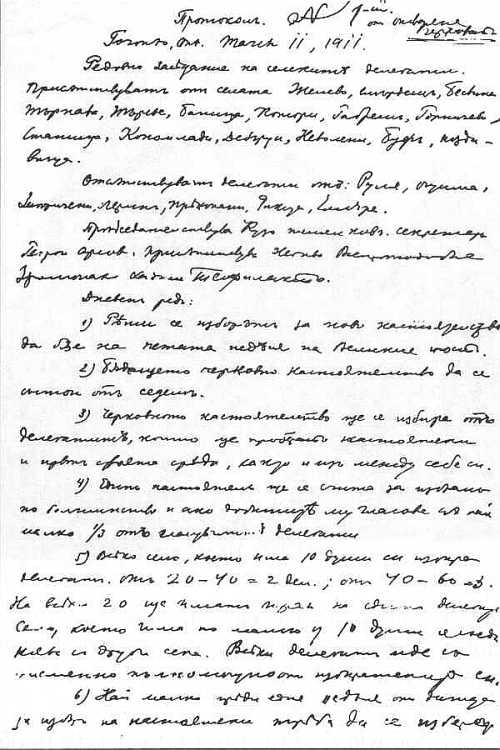
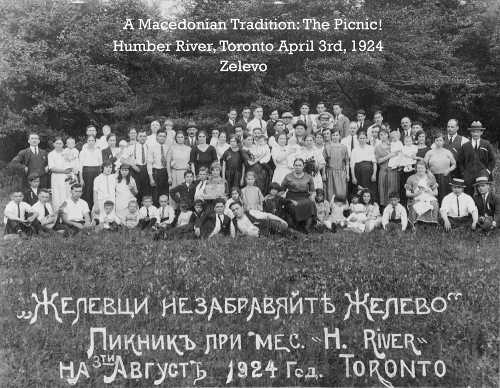
Here is another picture of the same
church in Toronto. It was made during the visit of Stefan Panaretov,
Bulgarian Minister Plenipotentiary
in North America, to the Bulgarian colony in Toronto. Again
Bulgarian flags are seen on the facade of the church.














